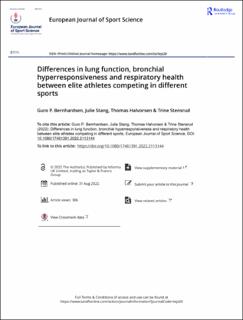| dc.contributor.author | Bernhardsen, Guro Pauck | |
| dc.contributor.author | Stang, Julie | |
| dc.contributor.author | Halvorsen, Thomas | |
| dc.contributor.author | Stensrud, Trine | |
| dc.date.accessioned | 2022-11-29T16:42:24Z | |
| dc.date.available | 2022-11-29T16:42:24Z | |
| dc.date.created | 2022-09-17T19:24:06Z | |
| dc.date.issued | 2022 | |
| dc.identifier.citation | European Journal of Sport Science. 2022, Artikkel 2113144. | en_US |
| dc.identifier.issn | 1746-1391 | |
| dc.identifier.uri | https://hdl.handle.net/11250/3034837 | |
| dc.description | This is an Open Access article distributed under the terms of the Creative Commons Attribution-NonCommercial-NoDerivatives License (http://creativecommons.org/licenses/by-ncnd/4.0/), which permits non-commercial re-use, distribution, and reproduction in any medium, provided the original work is properly cited, and is not altered, transformed, or built upon in any way. | en_US |
| dc.description.abstract | The aim of this study was to examine lung function, bronchial hyperresponsiveness (BHR) and exercise-induced respiratory symptoms in elite athletes performing different sports. Norwegian national-team athletes (30 swimmers, 32 cross-country skiers, 16 speed-skaters, 11 rowers/paddlers, 17 handball players and 23 soccer players) completed a validated questionnaire, measured exhaled nitric oxide (FENO), spirometry, methacholine provocation (PD20met) and skin prick test. Three cut-off levels defined BHR; i.e. PD20met ≤2 μmol, ≤4 μmol and ≤8 μmol. Mean forced vital capacity (FVC) was highest in swimmers (Mean z-score[95%CI] = 1.16 [0.80, 1.51]), and close to or higher than reference values according to the Global Lung Initiative equation, across all sports. Mean forced expiratory volume in 1 s (FEV1) was higher than reference values in swimmers (0.48 [0.13, 0.84]), and ball game athletes (0.69 [0.41, 0.97]). Mean forced expiratory flow between 25 and 75% of FVC (FEF25-75), and/or FEV1/FVC were lower than reference values in all endurance groups. BHR defined by ≤2 and ≤8 μmol methacholine was observed in respectively 50%–87% of swimmers, 25%–47% of cross-country skiers, 20%–53% of speedskaters, 18%–36% of rowers/paddlers, and 0%–17% of the ball game athletes. Exercise-induced symptoms were common in all groups, most frequent in cross-country skiers (88%), swimmers (83%) and speed-skaters (81%). | en_US |
| dc.language.iso | eng | en_US |
| dc.subject | elite athletes | en_US |
| dc.subject | endurance sport | en_US |
| dc.subject | lung function | en_US |
| dc.subject | respiratory health | en_US |
| dc.subject | team sport | en_US |
| dc.title | Differences in lung function, bronchial hyperresponsiveness and respiratory health between elite athletes competing in different sports | en_US |
| dc.type | Peer reviewed | en_US |
| dc.type | Journal article | en_US |
| dc.description.version | publishedVersion | en_US |
| dc.rights.holder | © 2022 The Author(s) | en_US |
| dc.source.pagenumber | 10 | en_US |
| dc.source.journal | European Journal of Sport Science | en_US |
| dc.identifier.doi | 10.1080/17461391.2022.2113144 | |
| dc.identifier.cristin | 2052704 | |
| dc.description.localcode | Institutt for idrettsmedisinske fag / Department of Sports Medicine | en_US |
| dc.source.articlenumber | 2113144 | en_US |
| cristin.ispublished | true | |
| cristin.fulltext | original | |
| cristin.qualitycode | 1 | |
